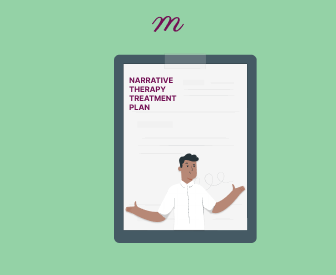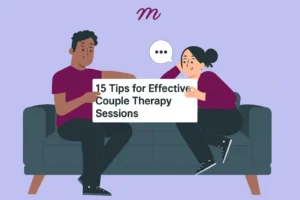Writing a narrative therapy treatment plan is a client-centered process that involves collaboration and a thorough understanding of the client’s story. The therapist must be skilled at assisting the client in reshaping their story in an empowering, strengths-focused, value-driven manner. Follow these steps to write the treatment plan, considering the list of questions you may ask your clients:
Steps To Write A Narrative Therapy Treatment Plan
- Identify the Client's Dominant Problem Story
- Start by asking the client to tell their story.
“Can you share with me what’s been going on lately?”
“What are the challenges you’re dealing with right now?”
“How would you describe your situation?”
“What’s the hardest part of what you’re experiencing?”
“What’s the problem you feel is holding you back?”
“How would you describe the challenges in your life?”
- Externalize the Problem
- Support the client in externalizing the problem, which means naming it as something separate from them.
“How would you describe this problem, as if it’s separate from you?”
“If you named this problem, what would you call it?”
“When did this problem first show up in your life?”
“What does the problem want you to believe about yourself?”
“How does this problem affect your day-to-day life or relationships?”
- Help the client understand the problem is not who they are but something they are dealing with.
- Write down the client's problem as something external.
- Example: "Client identifies suicidal ideation as an external force that disrupts their daily life."
- Explore the Influence of the Problem
- Ask the client to explore how the problem affects different areas of their life.
“How does the problem impact different parts of your life (work, school, family, social)?”
“What does the problem try to make you do? Make you think?”
“How do you feel when the problem is present in your life?”
“What decisions have you made because of the problem?”
- Clearly outline the areas the problem influences.
- Example: “Suicidal ideation affects the client's ability to focus at work and build strong relationships.”
- Identify Unique Outcomes
- Explore times when the client resisted or overcame the problem, even if only briefly. These are unique outcomes.
“Can you think of a time when the problem wasn’t in control, even if just for a brief time?”
“What was different during that time when the problem didn’t have so much power over you?”
“What did you do during that time that you usually struggle with?”
“How did you feel when the problem wasn’t as strong?”
- Write these positive times into the treatment plan as opportunities to develop new narratives.
- Example: “Client reported feeling more in control during a recent family vacation.”
- Generate Alternative Narratives
- Help the client create an empowering story based on the unique outcomes.
“What does the unique outcome tell you about your strengths?”
“What do you think this says about who you really are, separate from the problem?”
“How could you use this strength, skill, or ability to take more control over the problem?”
“What would your life look like if the problem had less control over you?”
- Write down the client’s new, positive narrative.
- Example: “Client is learning to view themselves as someone capable of regulating their emotions.”
- Set Goals
- Collaborate with the client to set clear therapy goals based on the new narrative.
“What’s one step you can take to build on those moments when you’re stronger than the problem?”
“What would change in your life if the problem had less power over you?”
“How would your relationships improve if you could weaken the problem’s control?”
“What is one thing you can do this month to take control back from the problem?”
“What would you like to achieve as you continue to manage this problem?”
“What small step can you take to move toward your new story?”
- Write specific, measurable, achievable, relevant, and time-bound (SMART) goals.
- Example: “Client will reduce the frequency of their suicidal thoughts from multiple times a day to no more than once a day within the next four weeks by practicing at least two coping strategies (grounding exercises or calling a support person) whenever these thoughts arise. They will check in with their therapist weekly to review progress.”
- Define Strategies and Interventions
- Choose therapeutic strategies that align with the client’s goals and strengths. Examples might be daily journaling about positive experiences, continuing to explore unique outcomes in future sessions, or connecting with a supportive person.
- Outline which interventions will be used and how they will support the client’s new narrative.
- Evaluate Progress
- Periodically revisit the treatment plan with the client, assessing what’s working and adjusting as needed.
“How have you felt since we began referring to the problem as something separate from you?”
“What new understanding have you gained about yourself through this process?”
“What have you noticed about your ability to challenge the problem in your life?”
“As you think about the future, how do you see yourself continuing to reshape your story?”
“How do you feel about your progress so far?”
“What adjustments should we make to continue improving?”
- Update the treatment plan regularly to reflect the client’s progress.
Sample Treatment Plan
Problem Story (Externalized):
The client identifies alcohol addiction as a force that interrupts daily life and social interactions.
Impact of the Problem:
Alcohol addiction affects the client's ability to function at work and participate in social events.
Unique Outcomes:
The client experienced moments of calm and clarity during family gatherings and social events where alcohol had less influence.
Alternative Narrative:
The client is beginning to see themselves as capable of managing alcohol addiction.
Goals:
The client will practice mindfulness exercises daily.
The client will attend three AA meetings per week.
Interventions:
AA Meetings, weekly mindfulness practice, daily physical exercise, journaling about positive experiences, and discussing unique outcomes in therapy sessions.
Evaluation:
The client shows progress in abstaining from alcohol consumption and feels more confident in social settings. Will continue to attend AA meetings, practice mindfulness, exercise daily, and identify additional unique outcomes.
Following these steps, the narrative therapy treatment plan will empower the client through their stories and strengths and provide a clear roadmap for change.
Reference
White, M. and Epston, D. (1990). Narrative Means to Therapeutic Ends, 1st Edition, W. W. Norton & Company.
Why other mental health professionals love Mentalyc

“It immediately changed my quality of life, personally and professionally. I went from 3–4 hours a week of notes to 1 hour at most … that alone is invaluable personally and professionally.”
Owner/Independently Licensed Marriage & Family Therapist (IMFT)

“For those who have hesitations … It is a lifesaver. It will change your life and you have more time to be present with your patients.”
Licensed Clinical Social Worker

“If I were recommending this software to a colleague, I would tell them that it is the best thing that they could do for their practice.”
Licensed Professional Counselor

“Do yourself a favor, make your life easier. Use the tools that are readily available … I found Mentalyc to be one of the best tools that I’ve ever used.”
Licensed Marriage and Family Therapist







